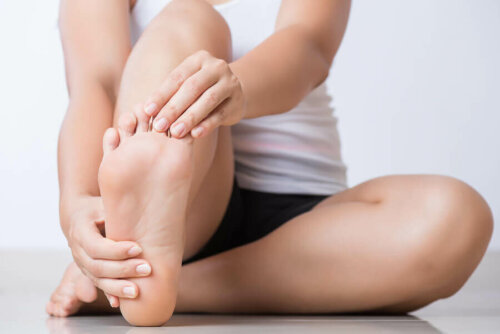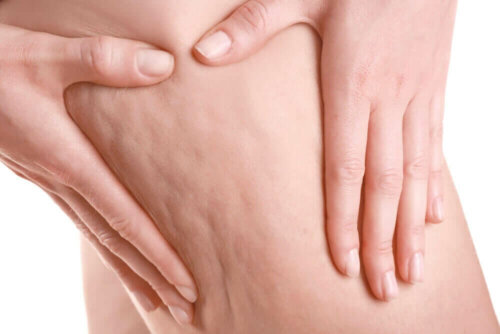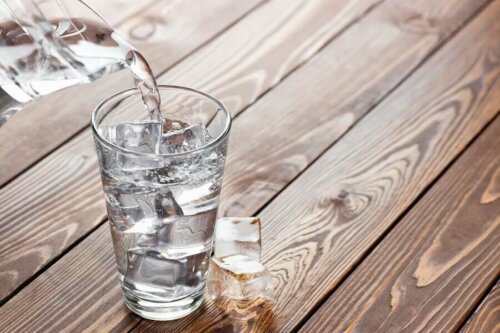Five Common Symptoms of Liquid Retention

Do you know what the common symptoms of liquid retention are? Surely, when you think about it, you may have in mind the characteristic swelling of the legs, but you have some doubts as to what other discomforts may occur at the same time.
Don’t worry, below we’ll discuss the common symptoms of liquid retention and other interesting information that’ll allow you to both prevent and better address this problem so that it doesn’t affect your well-being. So, are you ready? Let’s get to it!
Liquid retention is a common problem
While it is not classified as a disease, it appears as a warning of other, more serious conditions. Therefore, these could be circulatory difficulties, obstructions in the lymphatic system, and hormonal imbalances. Furthermore, it’s can also be due to excessive salt consumption and other issues.
Since it can cause discomfort in daily life, we recommend consulting a doctor to find out the cause. Additionally, what measures should be applied, and what is the best treatment for your case.
It occurs most frequently in our lower extremities, but it can also affect our hands, arms, face, and abdomen.

Although sometimes it goes unnoticed, it almost always triggers a series of reactions in the body due to the lack of control that occurs in the inflammatory processes.
For that reason, and to avoid complications, it is important to understand how it starts and what habits can help to control it.
Symptoms of liquid retention you shouldn’t ignore
Mild cases of liquid retention go unnoticed or are confused with a slight weight increase. However, when it starts to get more serious, it causes a series of symptoms that can reduce one’s ability to carry out daily tasks.
1. Inflammation in extremities
Noticeable swelling in the lower and upper extremities can be enough to highlight a liquid retention problem. Furthermore, the extremities will appear larger than normal and can present circulatory problems because of the pressure that the valvular system is under, due to the excess water.
Other inflamed areas may be the abdomen, chest, or face.
2. Feeling of laziness
It’s common to feel a strong sense of laziness in your body as a result of this condition. This is especially noticeable when doing physical activity.
The abnormal accumulation of liquids adds to your body weight, which affects your muscular, lymphatic, and circulatory health.
3. Cellulite

There are many factors that influence the appearance of cellulite in the glutes and legs. However, when it is caused by retention, it can become more noticeable and difficult to treat.
Although many external treatments help to reduce it, it is very important to treat liquid accumulation to notice an improvement.
*To obtain the appropriate treatment for your case, it’s best to consult your family doctor or directly with the dermatologist.
Read more: Three Menus to Try for Cellulite Prevention
4. Fatigue and general discomfort
When there’s something wrong with the body, it’ll try to compensate for the imbalances by exerting more effort, which often leads to fatigue. Therefore, another common symptom of fluid retention is fatigue and general discomfort.
5. Decrease in urination
Since the kidneys cannot correctly process the liquids in the body, you have to urinate less and this increases the risk of infections in the urinary system.
How to prevent liquid retention
There are many habits and remedies that can help to prevent and treat this problem. Even though many factors influence its appearance, improving your lifestyle can significantly minimize the risk.
Limit your salt consumption
Excessive salt consumption produces imbalances in the body that cause water accumulation in our tissues.
Because of that, it’s important to limit its consumption, not only avoiding table salt but also reducing your ingestion of foods like:
- Sausages
- Aged cheese
- Canned foods
- Junk food
- Overly processed foods
- Alcoholic and carbonated drinks
Increase your water consumption to avoid liquid retention

Not drinking enough water and healthy beverages is the main cause of liquid retention. Furthermore, drinking water regulates circulation and optimizes the work of your kidneys.
Diuretic food
There is a large variety of diuretic foods that can help with the process that remove excess liquids from the body.
The most recommended are:
- Pineapple
- Watermelon
- Cantaloupe
- Ginger
- Artichoke
- Beets
- Asparagus
You might like: Harvard Study Recommends Not Drinking Low-Fat Milk
Avoid using tight clothing
Clothing that’s too tight impedes proper blood circulation. Furthermore, it can influence the appearance of edema, varicose veins, and other difficulties.
Exercise
Being sedentary, or staying in the same position for too long, can produce inflammatory imbalances in the body. Additionally, it can cause circulatory and retention problems.
Regularly exercising, for at least 20 to 30 minutes a day, activates circulation, improves cellular oxygenation processes. In addition, it supports the processes that help to keep the body clean and balanced.

Improve your habits if you have liquid retention
Now that you know the common symptoms of fluid retention, you can keep them in mind in case you ever experience them.
If you often suffer from liquid retention, start improving your lifestyle habits as soon as possible. As you do so, you’ll notice a great improvement on a daily basis. However, don’t forget to consult your doctor and follow their instructions.
All cited sources were thoroughly reviewed by our team to ensure their quality, reliability, currency, and validity. The bibliography of this article was considered reliable and of academic or scientific accuracy.
- De Micheli, Alfredo. “Miguel Servet y la circulación sanguínea pulmonar.” Archivos de cardiología de México 73.3 (2003): 171-174.
- Echevarría, Miriam, and Rafael Zardoya. “Acuaporinas: los canales de agua celulares.” Investigación y ciencia 12 (2006): 60-67.
- Figueroa-Damián, Ricardo, et al. “Consumo de agua en el embarazo y la lactancia.” Acta Pediátrica de México 34.2 (2013): 102-108.
This text is provided for informational purposes only and does not replace consultation with a professional. If in doubt, consult your specialist.








